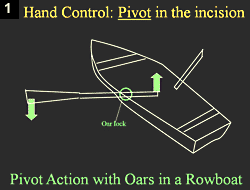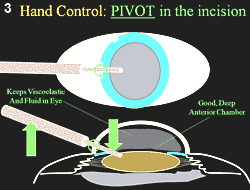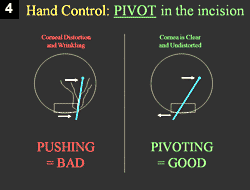Instrument usage techniques offered to phaco surgeons
Proper application includes correct hand positioning, a light grip, delicate pivoting and keeping the eye in primary gaze.

We spend many years writing and developing the neural pathways for fine hand motor control before we ever pick up a phaco probe. It is easier and more natural for most phaco surgeons to hold the phaco probe like a pen, particularly given the pen-like shape of the probe.
The strength of the grip is inversely related to the fine motor control: The lighter the grip, the better the control. If I had a stack of 10 sheets of paper interspersed with sheets of carbon paper, and then I asked you to write forcefully enough so that even the bottom carbon copy was legible, you would utilize a strong grip. But the quality of the writing would be poor. On the other hand, if I asked you to write as neatly as possible on a single sheet of paper with your prettiest calligraphy writing, you would use a fine, light grip. This fine, light grip is best suited for the phaco probe and for intraocular surgery.
The position of the hands should be at the patient’s eye level, with both hands resting comfortably with the shoulders relaxed. The hands can lightly rest on the patient’s draped face/head or on a separate wrist-rest. The control of the phaco probe and intraocular instruments is primarily from the fingers and somewhat from the wrists; gross movements of the forearms, arms, elbows and shoulders are not well-suited for ocular surgery.
 Uday Devgan |
Pivoting
The instruments, particularly the phaco probe, should float within the incision. There should be no forceful pushing on any aspect or edge of the incision. With any instrument, distorting the incision can deform the cornea and impair the view within the eye. With the delicate balance of fluidics in phacoemulsification, distorting the incision can lead to excessive leakage and an unstable chamber leading to a high risk of capsule rupture. Finally, remember that the ultrasonic energy from the phaco probe can produce a significant amount of heat and that forcefully pushing the phaco needle on the edge of the incision can burn the cornea in a matter of seconds. Floating within the incision is key.
In order to maneuver within the eye without pushing on the incision, we need to pivot our instruments. The action is similar to rowing action in a row boat: The paddle is placed within an oarlock (analogous to our incision), and in order to push water away from us with the paddle, we pull the handles toward us (Figure 1).
In the eye, when you want to move the phaco tip downward, you do not push down on the incision. Rather, you lift the back end of the phaco probe upward, which will cause pivoting within the incision, and the phaco tip will move downward. This is accomplished without deforming the incision, thus the chamber stays formed and the cornea remains undistorted (Figures 2 to 4).
|
|
|
|
Images: Devgan U |
|
Keeping the eye in primary gaze
With two incisions, the main incision and the paracentesis, and two instruments within the eye, the patient will not be able to move the eye, even under topical anesthesia. This two-point fixation is another advantage of two-handed surgery. One-handed techniques of phacoemulsification are relatively outdated, and as such, I do not teach them to my residents or students.
The surgeon’s best view and most maneuverable state is when the eye is in primary gaze while the patient is in the supine position. By floating in the incision, we can keep the eye in this primary position. Any forceful pushing of the instruments within the eye will cause the eye to move away from the force vector – usually toward the medical canthus. This is dangerous because it limits the surgeon’s view and maneuverability in the eye.
Adjust your hand position so that there is no pushing on any aspect of the incision, and you will find that the eye will return to primary gaze. In cases of topical anesthesia, the patient can assist you further by looking directly at the microscope light.
In summary, keep the hand position correct and comfortable, keep the instrument grip fine and delicate, keep the instruments floating gently within the incision and keep the eye in primary gaze by pivoting the instruments.
For more information:
- Uday Devgan, MD, FACS, is in private practice at Devgan Eye Surgery in Los Angeles, Beverly Hills, and Newport Beach, California. Dr. Devgan is Chief of Ophthalmology at Olive View UCLA Medical Center and an Associate Clinical Professor at the Jules Stein Eye Institute at the UCLA School of Medicine. Dr. Devgan can be reached at 11600 Wilshire Blvd., Suite 200, Los Angeles, CA 90025; 800-337-1969; fax: 310-388-3028; e-mail: devgan@gmail.com; Web site: www.DevganEye.com. Dr.Devgan is a consultant to Abbott Medical Optics and Bausch & Lomb, and is a stockholder in Alcon Laboratories and formerly in Advanced Medical Optics.












